Samsung Galaxy S 4 Review - Part 1
by Brian Klug on April 24, 2013 12:01 AM ESTBattery Life and Charge Time
The Galaxy S 4 features a removable 9.88Wh battery with 3.8V chemistry. The battery design is par for the course for any high end smartphone, but the fact that it's removable remains a staple of the Galaxy S design. Whether or not the bulk of consumers actually use the flexiblity offered by a removable battery is up for debate, but there's no doubt about the fact that Samsung has a strong following of users who appreciate the feature.
Unfortunately, only having access to the Sprint version of the Galaxy S 4 to review, most of our battery life tests on the cellular network aren't all that useful. The good news is that our WiFi tests should at least give you an idea of how well the SGS4 will compare to the HTC One when both are on the same network. We're using the latest revision of our smartphone battery life test to compare performance of all the key players here. This is now our sixth revision of the battery life test, and we feel is the optimal balance between challenging workloads and idle time. The basic overview is the same as the previous test — we load webpages at a fixed interval until the handset dies, with display set at exactly 200 nits as always. Power saving features are disabled if they turn on automatically, and background account sync is disabled. The test is performed over both cellular data on all available air interfaces and over WiFi in an environment with good signal levels. The new test has decreased pause time between web page loads and added a number of JavaScript-heavy pages. I sat down with some UMTS RRC (Radio Resource Control) emulator tools and also made sure we had a good balance of all the RRC states (DCH, PCH if possible, FACH, IDLE) so we weren’t heavily biased towards one mode or the other.
As the most relevant comparison of platforms we have today, we'll start with the WiFi version of our web browsing test:
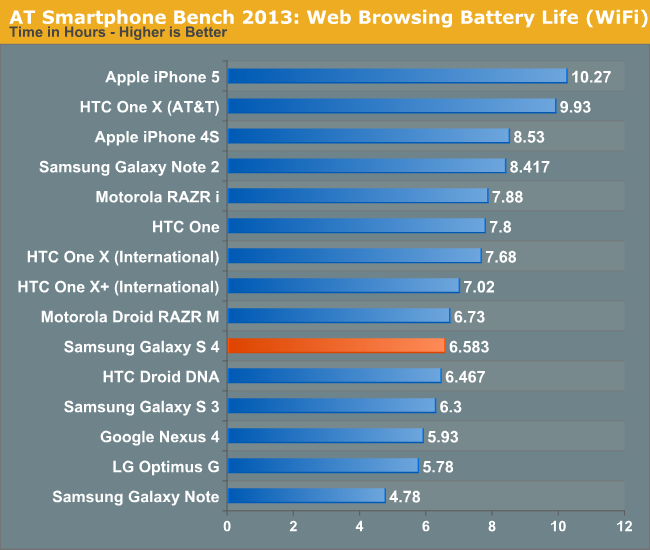
On WiFi the Galaxy S 4 falls behind the HTC One by an appreciable amount, however there's still an improvement in battery life compared to the Galaxy S 3. The Galaxy S 4's battery life isn't bad by any means, but do keep in mind that this is a large phone with a large display and a very powerful SoC. For much of the past year we've been talking about an increase in dynamic range in total platform power of high end smartphones and the Galaxy S 4 is no exception. Run it at full brightness or keep many cores running in their maximum performance states for a considerable period of time and you'll be greeted by a phone that's quickly in need of a power outlet.
As I mentioned earlier, we only have access to the Sprint version of the Galaxy S 4 at this point which unfortunately means that our 3G results aren't all that comparable to other devices here.

Even on Sprint, the Galaxy S 4 does surprisingly well.
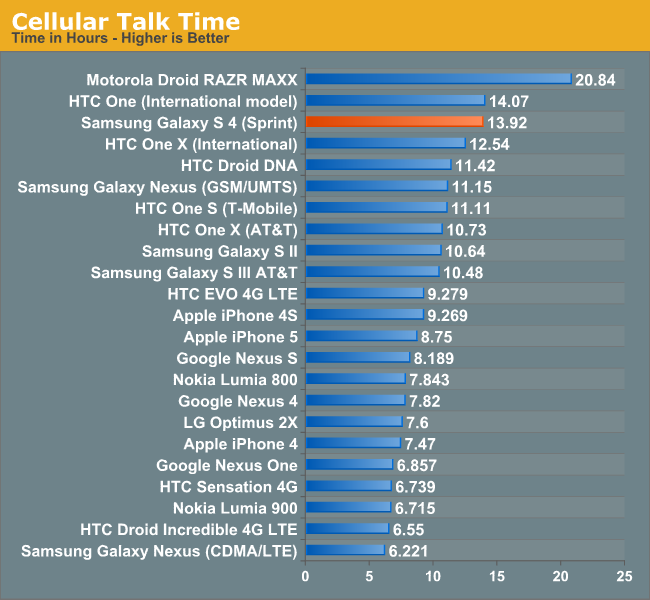
Talk time is excellent on the Galaxy S 4, with the phone delivering effectively the same battery life as the HTC One. Without having to power on that huge display, the Galaxy S 4 can last for a very long time on a single charge.
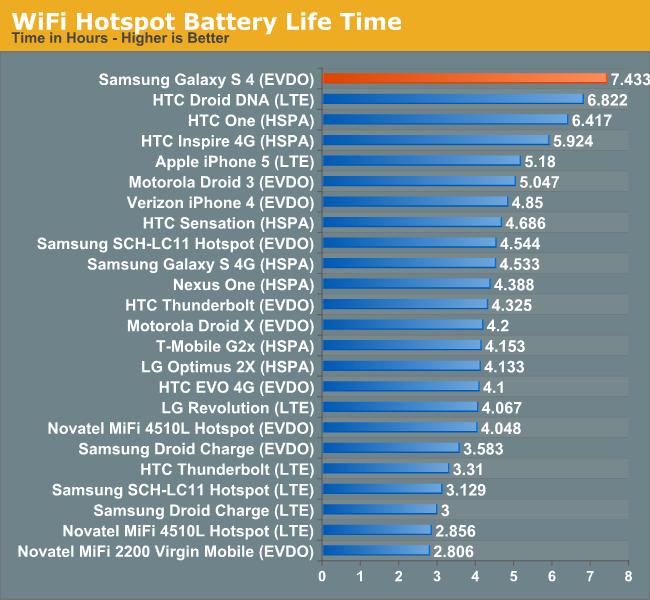
A combination of the Sprint network and the fact that the Galaxy S 4's display remains off during our hotspot test resulted in great battery life here as well. Again, this data isn't all that useful if you're not on Sprint but Samsung tells us we should be able to get our hands on an AT&T SGS4 in the not too distant future.
Charge Time
Samsung appears to implement Qualcomm's Quick Charge specification in the Galaxy S 4 and its bundled charger. I realize we haven't done a deep dive into what Quick Charge is and how it works, but I'll try to go through a quick explanation here. Most conventional chargers are linear, they take a fixed amount of input current (at 5V) and pass it along to the device being charged. The problem is that at deeply discharged states, the device's battery might be at a substantially lower voltage. A traditional linear charger won't change the current supplied based on the voltage of the battery being charged, and as a result can deliver sub-optimal charge times. When implemented, Qualcomm's Quick Charge technology can vary output current based on the voltage of the battery being charged, which results in less power being dissipated as heat and more being delivered to charging the battery itself. The table below helps illustrate the savings:
Quick Charge, at least in its currently available 1.0 specification, is still bound by the 5V limits of the USB BC 1.2 specification. The next revision of Quick Charge will enable higher voltage operation for even faster charge times.
| Qualcomm Quick Charge 1.0, Theoretical Example | ||||||
| Input Current @ Voltage | Input Power | Output Current @ Discharged Battery Voltage | Output Power | |||
| USB BC 1.2 - Linear Charger | 475mA @ 5V | 2.375W | 475mA @ 3V | 1.425W | ||
| Qualcomm Quick Charge 1.0 | 475mA @ 5V | 2.375W | 700mA @ 3V | 2.100W | ||
The non-linear nature of Quick Charge significantly shortens charge time, particularly in the very early stages of charging when the device's battery is presumably fully discharged. As the device's battery voltage increases, current delivery tapers off and the QC advantage is no longer as great as a standard USB BC 1.2 solution. The end result though is significantly improved charge times.
The graph below shows the benefits of using Samsung's own charger vs. a standard charger that implements the USB BC 1.2 specification. When used with the bundled charger, the Galaxy S 4 recharges much faster than HTC's One, despite using a larger battery. Obviously the Galaxy S 4 will charge with any USB charger, but the charge time will simply be longer. Samsung uses a voltage divider and signals the presence of their own charger by sending 1.2-1.3 V across the D+ / D- pins, this is similar to what Apple does with 2.0 or 2.8 V across the pins for various USB chargers they've shipped over the years. This signaling is essentially Samsung's proprietary tablet charging signaling which they've employed on the Galaxy Note 2 and now SGS4, in fact the two use the same exact charger, so it's worth tossing out your old ones and getting the appropriate one to take advantage of the faster charging.
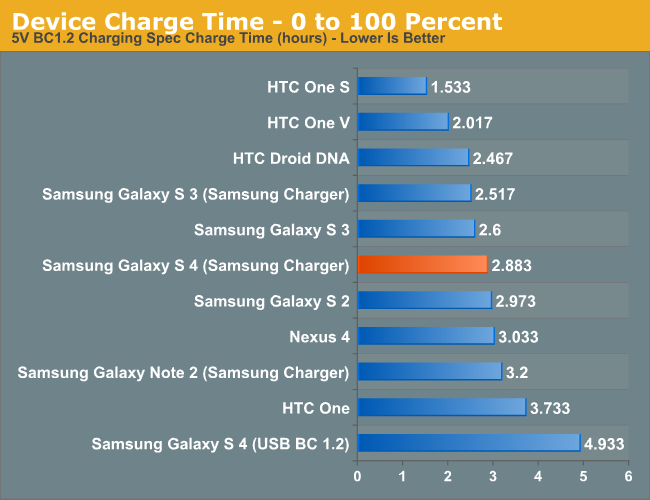


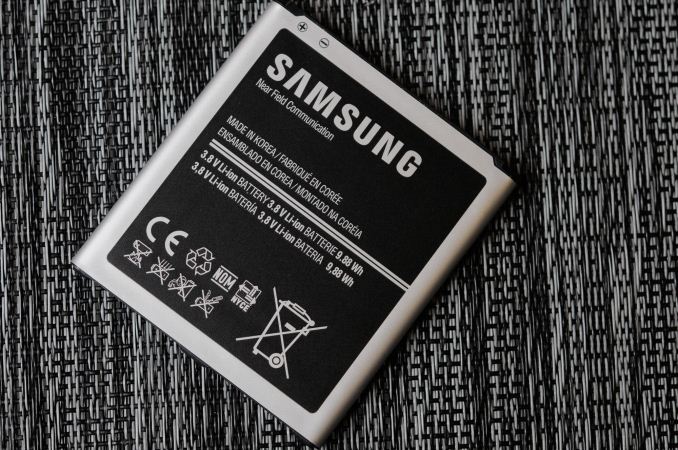








335 Comments
View All Comments
redchar - Wednesday, April 24, 2013 - link
I'm shocked to hear on a tech site that there's a person who would prefer the HTC One. And why not plastic? It's no mystery why plastic is a popular material. It's lightweight, cost efficient, and comes in a variety of styles and textures to allow creativity and good looks (granted, samsung's plastic is rather bland compared to the type you'd find on older HTC phones). Beyond that, plastic even has/plasticity/
That's right. A type of material that withstands drops instead of denting, being put on mobile devices such as laptops and phones. Crazy, right? I wish HTC would go back to plastic, among other bad changes they've made.
And to top it off, the HTC One, like many "high end" HTC phones as of late, does not include a memory slot or a removable battery. With such useful, and easy-to-implement features, it's a wonder that anyone would consider it a high end phone. And no surprise that galaxy phones all sell very well during a time where the industry is leaving out major functionality and at the same time struggling to sell as many units as they'd like (I wonder why?).
While the SGS4 is by no means a perfect device (it's too large, and with a pointlessly high resolution screen that might impact performance in some way [perhaps battery life as a result of trying to maintain good screen brightness, or stressing the GPU more]), it does contain a list of features that you'd expect for a phone of its price. The only thing the HTC One has over it is the sort of camera people wanted all along: quality, not megapixels.
MilwaukeeMike - Wednesday, April 24, 2013 - link
While I understand you're point, there are a lot of people who disagree with you. The iPhone has no SD card, no removable battery and is made out of metal and it's sold quite well. I've always ripped them for leaving out a card slot and charging $100 for an extra 16GB. But HTC gives you 32GB in it's base model and charges more for an extra 32, not 16. They also have USB on-the-go, which allows your phone to host a USB drive with a $3 adapter. Sure, that's a workaround, but it's enough for me. No removable battery is a bit of a bummer, but my battery is still going strong 30 months later in my current phone, so I'm not worried about it getting old and dying. I also have chargers everywhere because micro USB is so common, so I'm not worried about getting stranded either.Thegonagle - Wednesday, April 24, 2013 - link
Plastic is lower cost than metal for Samsung, but not necessarily for me. As a consumer, Samsung's cost is irrelevant. Please don't mention the cost merits of plastic until the S4 is less expensive than the HTC One.crypticsaga - Wednesday, April 24, 2013 - link
^This. I don't understand why with the iphone5 and HTC one available anyone would buy a Samsung S. You get less for more money. If you make the argument about battery and SD card then I would expect that you use more than 32GB of space and carry around a spare battery in your pocket. The funny thing is I have yet to meet a samsung owner who actually does.danbob999 - Wednesday, April 24, 2013 - link
You get a faster SoC, more sensors, a larger display, a smaller and lighter device, a larger battery and more supported LTE bands.Not everyone cares about the look of a phone.
sigmatau - Thursday, April 25, 2013 - link
You also get a worse screen and speaker than the HTC One.mrochester - Friday, April 26, 2013 - link
Those features are of questionable day to day value, however. I gain far more from having a device that looks great every time I use it in comparison to features I might use once in a blue moon, but the device is sinfully ugly.tipoo - Sunday, April 28, 2013 - link
The SoC is basically a wash between the One and the S4, it's the same SoC just with the slightest amount more speed in one.dyc4ha - Wednesday, April 24, 2013 - link
That is like saying I bought a Ferrari with cheap plastic seats while the same-priced Lambo came with leather seats and it doesnt matter to you. Wha?blue_urban_sky - Friday, April 26, 2013 - link
Yes that is exactly what its like saying. because everyone has the same priorities as you and will buy a super car based on seat material.